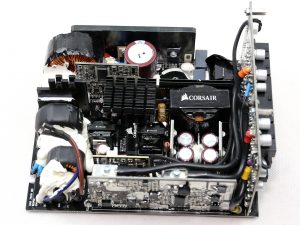|
General Data |
|
|
Manufacturer (OEM) |
CWT |
|
Platform Model |
Custom made for Corsair |
|
Primary Side |
|
|
Transient Filter |
6x Y caps, 2x X caps, 2x CM chokes, 1x MOV |
|
Inrush Protection |
NTC Thermistor & Diode |
|
Bridge Rectifier(s) |
2x |
|
APFC MOSFETS |
2x Infineon IPA50R140CP (550V, 15A @ 100°C, 0.14Ohm) |
|
APFC Boost Diode |
1x CREE C3D08060A (600V, 8A @ 152°C) |
|
Hold-up Cap(s) |
2x Chemi-Con (400V, 470uF & 390uF, 2000h @ 105°C, KMW) |
|
Main Switchers |
2x Infineon IPA50R140CP (550V, 15A @ 100°C, 0.14Ohm) |
|
APFC Controller |
Texas Instruments UCC28070 & CM03X |
|
LLC Resonant Controller |
Infineon ICE2HS01G |
|
Topology |
Primary side: Half-Bridge & LLC Resonant Controller |
|
Secondary Side |
|
|
+12V MOSFETS |
6x Infineon BSC014N04LS (40V, 100A @ 100°C, 1.4mOhm) |
|
5V & 3.3V |
DC-DC Converters: 3x Ubiq QM3004D (30V, 40A @ 100°C, 8.5mOhm), 3x Ubiq QM3006D (30V, 50A @ 100°C, 5.5mOhm) |
|
Filtering Capacitors |
Electrolytics: Nippon Chemi-Con (1-5,000 @ 105°C, KZE), Nippon Chemi-Con (4-10,000 @ 105°C, KY) |
|
Supervisor IC |
Weltrend WT7502 (OVP, UVP, PG, SCP), 2x Weltrend WT7518 (OCP, PG, SCP) |
|
Fan Model |
NR135P (135mm, 12V, 0.22A, Fluid Dynamic Bearing) |
|
Fan Controller |
Microchip PIC16F1503 |
|
5VSB Circuit |
|
|
Mosfet / Rectifier |
1x ISD04N65A (650V, 4A, 2.5Ohm), 1x QM3004D (30V, 40A @ 100°C, 8.5mOhm), 1x MBRU2045CT SBR (45V, 20A @ 125°C) |
|
Standby PWM Controller |
On-Bright OB5269CP |
This is the same platform as the HX850 and HX1000 models – with some minor differences.
At the primary side we see a half-bridge topology along with an LLC resonant converter for increased efficiency. In the secondary side a number of FETs regulate the +12V rail while the minor rails are generated through a couple of DC-DC converters.
The build quality is high and only Chemi-Con electrolytic caps are used … unfortunately not the companies high-end lines but they will do a fine job and sustain good performance through time. Besides electrolytic caps a large number of polymer ones are also utilized.
In the secondary side there are no proper heatsinks, because the +12V FETs are highly efficient so several bus bars are enough to cool them down.
The first part of the transient is on the AC receptacle and it incorporates a couple of Y caps. The same filter continues on the main PCB with four additional Y caps, two X caps, a pair of CM chokes and an MOV (Metal Oxide Varistor) which protects the unit from spikes and voltage overshoots from the mains.
Two bridge rectifiers are used. One of them is totally covered by the while glue that CWT uses in order to avoid coil whine issues and also to secure the PSU's part in place, even under extreme shipping or usage conditions. The HX850 uses two Vishay LVB2560 here.
The APFC converter uses two Infineon IPA50R140CP FETs and a single CREE C3D08060A boost diode. The HX850 features two Infineon IPZ60R125P6 FETs and a CREE C3D10060A in this circuit. The bulk caps of the HX750 have 860uF combined capacity, which provides a long hold-up time.
The main switching FETs are two Infineon IPA50R140CP, which are configured in a half-bridge topology.
A vertical board hosts the LLC resonant controller, an Infineon ICE2HS01G IC. On the same board we also find the APFC controller, an Infineon ICE3PCS01G, and a CM03X Green PFC controller.
In the secondary side two daughter-boards host six Infineon BSC014N04LS. The HX850 has eight of those FETs while the HX1000 has ten.
The electrolytic filtering caps are provided by Chemi-Con and belong to the company's KZE and KY lines. A number of polymer caps is also used for ripple filtering. Those ones are by Chemi-Con and FPCAP, so they are of high quality.
It is worth mentioning here that the KZE are definitely not Chemi-Con's best electrolytic caps, but still they are preferred over Chinese, even Taiwanese, caps with notably better specifications and this is why they are widely used by the majority of high-end Corsair (and not only) PSUs.
Finally, the KZE caps in this unit are supported by a number of KY ones which have better specs and an adequate number of polymer caps which are much more tolerant to tough conditions.
The DC-DC converters use three Ubiq QM3004D and three QM3006D FETs. The common PWM controller is an Anpec APW7159C.
The 5VSB rail is regulated by a ISD04N65A FET and a MBRU2045CT SBR (Schottky Barrier Diode). We also found a QM3004D FET on the modular board which is probably also utilized by this rail. Lastly, the standby PWM controller is an On-Bright OB5269CP.
On the front side of the modular board a large number of FPCAP and Chemi-Con polymer caps provides an extra ripple filtering layer.
The modular board also hosts two Weltrend WT7518s, while a WT7502 is installed on the main PCB. All those three ICs, handle the platform's protection circuits.
The soldering quality is good. CWT keeps high standards in this section.
The fan control circuit uses a Microchip PIC16F1503 IC, which allows for smoother and more detailed control.
The NR1350P (135mm, 12V, 0.22A) fan model is the omnipresent in Corsair's high-end models. It uses a true fluid dynamic bearing and thanks to the highly relaxed fan profile and the semi-passive operation, it won't bother you with loud operating noise even under tough conditions.
 KitGuru KitGuru.net – Tech News | Hardware News | Hardware Reviews | IOS | Mobile | Gaming | Graphics Cards
KitGuru KitGuru.net – Tech News | Hardware News | Hardware Reviews | IOS | Mobile | Gaming | Graphics Cards











































